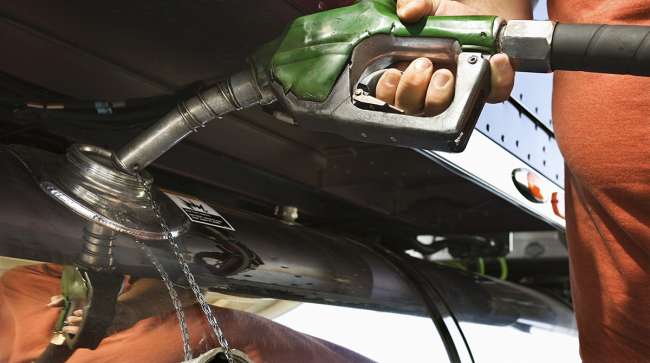Diesel Drops 1.5¢ to $3.136; Oil Close to Bear Market Price

[Stay on top of transportation news: Get TTNews in your inbox.]
The U.S. average retail price of diesel dropped 1.5 cents to $3.136 a gallon, the Department of Energy reported June 3.
Crude oil initially plunged to $53 a barrel and by midweek had reached bear market territory as the tensions surrounding international trade mounted.
Diesel costs 14.9 cents less than it did a year ago when it was $2.987, DOE said.
U.S. average #diesel fuel price on 6/03/2019 was $3.136/gal, DOWN 1.5¢/gallon from 5/27/19, DOWN 14.9¢/gallon from year ago https://t.co/XYf17OAQ53 #truckers #shippers #fuelprices pic.twitter.com/E10AfhsyyQ — EIA (@EIAgov) June 4, 2019
Regional diesel prices fell everywhere across the nation. The regional average that fell the most: 2.5 cents in California to $4.109 a gallon.
Also, the national average price for regular gasoline fell 1.5 cents to $2.807 a gallon, DOE’s Energy Information Administration said.
An executive at one truck maker extolled the fuel efficiency advantages of newer trucks.
“Over the last 10 years, there’s been about a 30% improvement in fuel economy performance alone, so if you’ve got a truck that’s between 5 and 10 years old, you’ve got the opportunity to save about $10,000 to $15,000 a year in just fuel costs, let alone all the uptime stuff that we’re now providing,” said Troy Clarke, chairman and CEO of Navistar International Corp., which makes the International brand of trucks.
U.S. average price for regular-grade #gasoline on 6/03/2019 was $2.807/gal, DOWN 1.5¢/gallon from 5/27/19, DOWN 13.3¢/gallon from year ago https://t.co/3z14HfogsL #gasprices pic.twitter.com/6T5rJPUeAx — EIA (@EIAgov) June 4, 2019
Jason Bates, chief financial officer at USA Truck Inc., was happy with his fleet of trucks whose average age is 2.5 years. Though he would not discuss the fleet’s actual fuel mileage, he said during an earnings call that it was “comfortably north” of 6.5 mpg.
“Even though we’ve made investments in tech, we still feel like we just, culturally, got some significant opportunity still on managing our fuel consumption. Whether it’s through idle reduction or out-of-route or deadhead [miles], things of that nature. We can just be smarter and better. Some of that is cultural and it takes time to change, but we’re really working on it,” Bates said.
Actual mpg depends on several factors, he added: the type of freight you’re hauling, what region you’re in and weather. “So there’s some dedicated routes, or Northeast-type base routes, where maybe are not getting that, but overall we’re shooting for that and better than that.”
Bates highlighted the effect of decisions made by key personnel, including Jeff Harris, the Van Buren, Ark,-based fleet’s vice president of maintenance, and the immediate past chairman of American Trucking Associations’ Technology & Maintenance Council.
“He and our director of procurement, Casey Borum, they put together a very detailed spec to make sure that we’ve kind of got the best-in-class stuff out there without breaking the bank,” Bates said. “And they both have decades of experience on figuring out what’s best-in-class and they work with our truck maker partners to really put together spec that makes a lot of sense, and, above all, has the safety parameters. We’re some of the first people to test out some of these new technologies on the safety side.”
West Texas Intermediate crude futures on the New York Mercantile Exchange closed at $53.25 June 3 compared with $59.14 per barrel May 28.
Futures have fallen 19.7% since they peaked April 23 at $66.30; a settlement at or below $53.04 would have achieved the 20% decline that defines a bear market, Bloomberg News reported.
On June 5, crude crossed that threshold and settled at $51.68 as the U.S.-China trade relationship worsened and the White House started a tariff fight with Mexico.
Investment banks Morgan Stanley and J.P. Morgan Chase & Co. warned of a recession if President Donald Trump follows through on threats to impose tariffs against Mexico. They are due to start June 10 at 5% and reach 25% by October.
....talks with Mexico will resume tomorrow with the understanding that, if no agreement is reached, Tariffs at the 5% level will begin on Monday, with monthly increases as per schedule. The higher the Tariffs go, the higher the number of companies that will move back to the USA! — Donald J. Trump (@realDonaldTrump) June 5, 2019
“What’s been very difficult is that supply has been falling very quickly, but then again, so has demand,” Francisco Blanch, global head of commodities research at Bank of America Merrill Lynch, said in a Bloomberg TV interview.
Investors have gotten “very rattled” by the trade disputes, Lori Calvasina, head of U.S. equity strategy at RBC Capital Markets, told Bloomberg. The bank recently downgraded the energy equities sector.
“We just can’t step in front of these demand concerns,” Calvasina said. “I don’t think energy investors give the energy sector enough credit when oil goes up but they certainly beat it to death when oil goes down.”
U.S. total petroleum stockpiles — including crude oil (minus the Strategic Petroleum Reserve), motor gasoline, distillate fuel oil, all other oils and crude in the SPR — jumped by 22 million barrels for the week ending May 31 to 1.952 billion barrels, the biggest increase shown in data going back to 1990, according to government figures.




